Seed Cracker Market
Seed Cracker Market Size and Share Forecast Outlook 2025 to 2035
Seed cracker market is projected to grow from USD 740.0 million in 2025 to USD 1,150.0 million by 2035, at a CAGR of 4.5%. Flax will dominate with a 30.0% market share, while retail will lead the channel segment with a 60.0% share.
Seed Cracker Market Forecast and Outlook 2025 to 2035
The global seed cracker market is projected to grow from USD 740.0 million in 2025 to approximately USD 1,150.0 million by 2035, recording an absolute increase of USD 410.0 million over the forecast period. This translates into a total growth of 55.4%, with the market expected to expand at a compound annual growth rate (CAGR) of 4.5% between 2025 and 2035.
The overall market size is anticipated to grow by nearly 1.6X, driven by increasing consumer preference for healthy snacking options, growing awareness of the nutritional benefits of seed-based products, and rising demand for gluten-free and plant-based alternatives across retail and foodservice applications.
Quick Stats for Seed Cracker Market
- Seed Cracker Market Value (2025): USD 740.0 million
- Seed Cracker Market Forecast Value (2035): USD 1,150.0 million
- Seed Cracker Market CAGR: 4.5%
- Leading Segment by Seed Type (2025): Flax (30.0%)
- Leading Segment by Channel (2025): Retail (60.0%)
- Leading Segment by Nature (2025): Conventional (80.0%)
- Key Growth Regions: Asia Pacific, North America, and Europe
- Top Companies by Market Share: Mary’s Gone Crackers, Lenny & Larry’s, Simple Mills
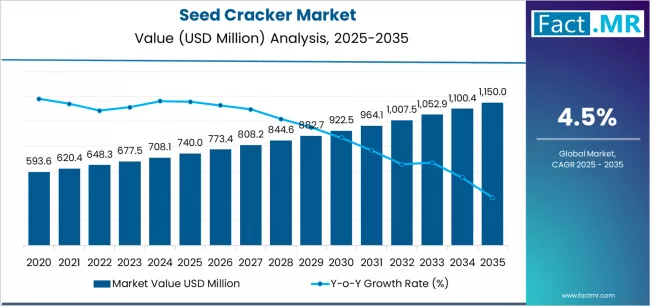
One of the key drivers of the market is the rising health consciousness among consumers, particularly in developed regions like North America and Europe, where a shift toward low-calorie, high-protein, and fiber-rich snacks is evident. Seed crackers, made from ingredients such as sunflower seeds, pumpkin seeds, flaxseeds, chia seeds, and sesame seeds, offer functional benefits including improved digestion, heart health support, and sustained energy release. This nutritional profile aligns with the growing wellness and functional foods trend, making seed crackers a preferred option among fitness enthusiasts, working professionals, and millennials.
The plant-based and gluten-free movement is another significant factor influencing market growth. With rising cases of gluten intolerance, celiac disease, and other dietary restrictions, consumers are increasingly seeking alternatives to traditional wheat-based snacks. Seed crackers, being naturally gluten-free and often minimally processed, cater to this demand, creating opportunities for product innovation and premium offerings. Manufacturers are responding by introducing flavored, fortified, and multi-seed varieties, as well as incorporating superfood ingredients like quinoa, millet, and hemp seeds to enhance both taste and nutritional value.
Retail and distribution channels are also evolving to support market expansion. The proliferation of e-commerce platforms, subscription snack boxes, and health-focused grocery stores has improved product accessibility and visibility. Meanwhile, the foodservice sector is gradually embracing seed crackers as part of menu innovations in cafés, bakeries, and health-focused quick-service restaurants, catering to a growing demand for wholesome snacking options on the go.
From a regional perspective, Asia-Pacific is expected to witness strong growth due to rising disposable incomes, urbanization, and increasing exposure to Western snacking habits. Countries like India, China, and Japan are seeing an uptick in the adoption of convenient and nutritious snack options, which is expected to further fuel demand. Europe and North America, while already established markets, will continue to lead in terms of innovation and premium product offerings.
Technological advancements in processing, baking, and extrusion techniques will further enhance product quality, shelf life, and texture, enabling manufacturers to cater to diverse consumer preferences. Additionally, growing emphasis on sustainable and traceable sourcing of seeds will appeal to environmentally conscious consumers, reinforcing brand loyalty and market penetration.
Overall, the seed cracker market is poised for sustained growth through 2035, driven by a convergence of health trends, dietary preferences, and innovative product development. Companies that focus on nutrient-rich formulations, flavor diversification, and strategic distribution will be best positioned to capture long-term opportunities in this expanding market.
Seed Cracker Market Key Takeaways
| Metric | Value |
|---|---|
| Market Value (2025) | USD 740.0 million |
| Market Forecast Value (2035) | USD 1,150.0 million |
| Forecast CAGR (2025-2035) | 4.5% |
Why is the Seed Cracker Market Growing?
| HEALTH & WELLNESS TRENDS | MANUFACTURING REQUIREMENTS | REGULATORY & QUALITY STANDARDS |
|---|---|---|
| Health-Conscious Consumer Behavior Continuous expansion of health and wellness awareness across established and emerging markets driving demand for nutritious snacking alternatives with high protein and fiber content. Plant-Based Diet Adoption Growing emphasis on plant-based nutrition and alternative protein sources creating demand for seed-enriched snacking products that deliver complete nutritional profiles. Gluten-Free Market Expansion Superior nutritional properties and digestive benefits making seed crackers essential for gluten-sensitive consumers and health-focused dietary applications. | Advanced Processing Technologies Modern food manufacturing requires advanced processing technologies delivering consistent texture, flavor, and nutritional integrity in seed-based cracker production. Processing Efficiency Demands Manufacturers investing in premium processing equipment offering consistent production while maintaining operational efficiency and cost-effectiveness. Quality and Reliability Standards Certified producers with proven track records required for advanced seed cracker manufacturing applications with consistent quality outputs. | Food Safety Standards Regulatory requirements establishing performance benchmarks favoring high-quality seed cracker materials with proven nutritional profiles. Performance Property Standards Quality standards requiring superior nutritional properties and resistance to environmental stresses during processing and storage. Industrial Compliance Requirements Diverse nutritional requirements and quality standards driving need for sophisticated seed-based ingredient inputs across manufacturing operations. |
Seed Cracker Market Segmentation
| Category | Segments Covered |
|---|---|
| By Seed Type | Flax, Chia, Sunflower, Others |
| By Channel | Retail, Online, Foodservice |
| By Nature | Conventional, Organic |
| By Region | North America, Europe, Asia Pacific, Latin America, Middle East & Africa |
Seed Cracker Market Analysis by Seed Type
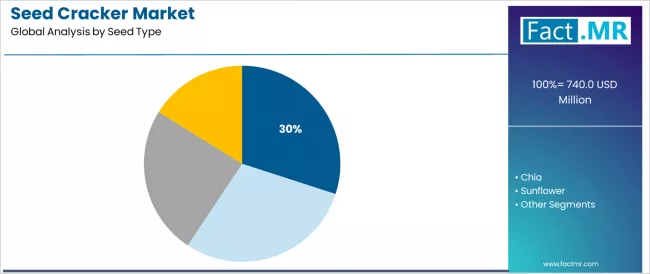
| Segment | 2025 to 2035 Outlook |
|---|---|
| Flax | Leader in 2025 with 30.0% market share; likely to maintain leadership through 2035. Broadest nutritional appeal (omega-3 fatty acids, fiber, lignans), mature supply chain, established consumer acceptance. Momentum: steady-to-strong. Watchouts: supply chain volatility affecting raw material costs. |
| Chia | Premium positioning with 25.0% market share driven by superfood status and exceptional nutritional density. Strong growth in health-conscious demographics and specialty retail channels. Momentum: rising. Watchouts: price sensitivity limiting mass market penetration. |
| Sunflower | Cost-effective option with 20.0% market share, well-established in mainstream retail channels due to familiar taste profile and competitive pricing. Momentum: steady growth in conventional segments; moderate growth in premium applications. |
| Others | Including pumpkin seeds, sesame, and mixed seed varieties. Limited individual market share but growing interest in specialized formulations requiring specific nutritional profiles. Momentum: selective growth in niche health-focused applications. |
Seed Cracker Market Analysis by Channel
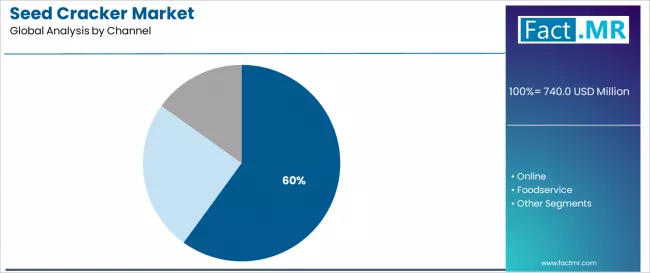
| Segment | 2025 to 2035 Outlook |
|---|---|
| Retail | At 60.0%, largest distribution channel in 2025 with established shelf presence in health food sections and mainstream grocery aisles. Mature supply chains, standardized packaging specifications. Momentum: steady growth driven by consumer convenience and product visibility. Watchouts: shelf space competition from expanding snack categories. |
| Online | Rapid growth segment with 25.0% share driven by direct-to-consumer brands and subscription services. Digital marketing advantages and customer education opportunities. Momentum: strong growth through 2030, supported by e-commerce expansion. Watchouts: fulfillment costs affecting profitability margins. |
| Foodservice | Specialized segment with 15.0% share serving restaurants, cafes, and institutional food providers. Growing demand for healthy menu options supporting premium positioning. Momentum: moderate growth via foodservice industry expansion and health-focused menu innovation. Watchouts: operational requirements affecting product specifications. |
Seed Cracker Market Analysis by Nature

| Nature | Status & Outlook 2025-2035 |
|---|---|
| Conventional | Dominant segment in 2025 with 80.0% share across mainstream retail applications. Established processing systems, cost advantages, broad consumer accessibility. Momentum: steady growth driven by mass market appeal and competitive pricing. Watchouts: increasing consumer preference for organic alternatives. |
| Organic | Premium segment with 20.0% share commanding higher prices through certified organic ingredients and processing. Value-add through health positioning, environmental benefits, specialty retail focus. Momentum: strong growth as organic food market expands. Processing complexity and certification requirements may limit rapid scaling. |
DRIVERS
| DRIVERS | RESTRAINTS | KEY TRENDS |
|---|---|---|
| Health Awareness Growth Continuing expansion of health and wellness activities across established and emerging markets driving demand for nutritious snacking alternatives with proven health benefits. Gluten-Free Market Expansion Increasing adoption of gluten-free dietary preferences creating importance in alternative grain products and specialized nutritional formulations. Premium Snacking Demand Growing demand for premium snacking products that support both nutritional benefits and convenient consumption in busy lifestyle applications. | Raw Material Price Volatility Price fluctuations in seed commodities affecting production costs and supply chain predictability for manufacturers. Manufacturing Complexity Complex technical requirements across applications affecting product development and standardization processes. Competition from Alternatives Alternative healthy snacking categories affecting market selection and consumer preference development. | Advanced Processing Technologies Integration of advanced food processing systems, manufacturing innovations, and quality control solutions enabling superior operational efficiency. Product Innovation Enhanced flavor profiles, improved texture control, and advanced nutritional capabilities compared to traditional cracker systems. Specialized Formulations Development of specialized seed cracker grades and custom formulations providing enhanced nutritional benefits and application-specific optimization. |
Analysis of Seed Cracker Market by Key Countries
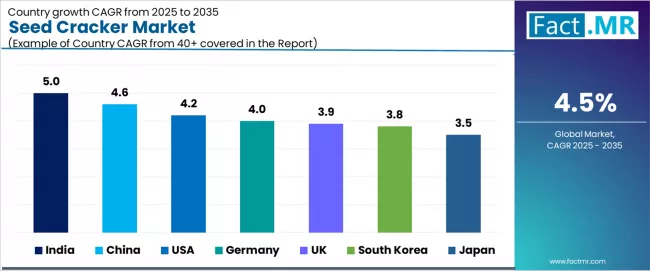
| Country | CAGR (2025-2035) |
|---|---|
| India | 5.0% |
| China | 4.6% |
| USA | 4.2% |
| Germany | 4.0% |
| UK | 3.9% |
| South Korea | 3.8% |
| Japan | 3.5% |
India Leads Global Market Growth with Health Innovation
Revenue from seed crackers in India is projected to exhibit strong growth driven by expanding health consciousness infrastructure and comprehensive nutritional snacking innovation creating opportunities for food manufacturers across retail operations, specialty health stores, and modern trade channels. The country's developing food processing tradition and expanding health awareness capabilities are creating demand for both conventional and premium seed-based snacking ingredients. Major food companies are establishing local manufacturing facilities to support large-scale production operations and meet growing demand for healthy snacking solutions.
- Health consciousness industry modernization programs are supporting widespread adoption of advanced food processing across manufacturing operations, driving demand for high-quality nutritional snacking products
- Nutritional processing excellence initiatives and specialized product development are creating opportunities for manufacturers requiring reliable ingredient sourcing and cost-effective seed-based solutions
- Retail expansion growth and food processing development are facilitating adoption of specialty seed cracker products throughout major urban regions
China Demonstrates Strong Market Potential with Food Processing Growth
Revenue from seed crackers in China is expanding supported by extensive food manufacturing development and comprehensive snacking industry growth creating demand for reliable healthy snacking products across diverse retail categories and specialty food segments. The country's dominant food production position and expanding consumer purchasing power are driving demand for seed cracker solutions that provide nutritional benefits while supporting cost-effective manufacturing requirements. Food processors and manufacturers are investing in local production facilities to support growing manufacturing operations and health-conscious consumer demand.
- Food manufacturing operations expansion and processing capability development are creating opportunities for seed cracker products across diverse retail segments requiring reliable nutritional content and competitive pricing
- Manufacturing modernization and processing technology advancement are driving investments in food supply chains supporting quality requirements throughout major industrial regions
- Health-conscious consumer growth and specialty food development programs are enhancing demand for processing-grade seed crackers throughout retail distribution areas
USA Maintains Strong Position with Premium Snacking Innovation
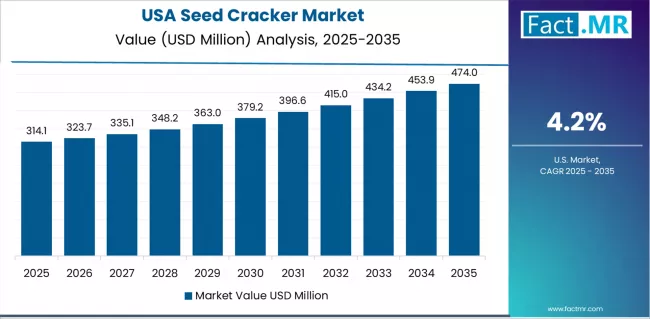
Demand for seed crackers in USA is projected to grow supported by the country's expanding healthy snacking market base and food processing technologies requiring advanced seed-based systems for retail distribution and specialty food applications. American food companies are implementing processing systems that support advanced manufacturing techniques, operational efficiency, and comprehensive quality protocols. The market is characterized by focus on operational excellence, nutritional performance, and compliance with food safety quality standards.
- Premium snacking industry investments are prioritizing advanced processing technologies that demonstrate superior nutritional value and quality while meeting American manufacturing standards
- Food processing leadership programs and operational excellence initiatives are driving adoption of precision-engineered seed cracker ingredients that support advanced manufacturing systems and performance optimization
- Research and development programs for nutritional enhancement are facilitating adoption of specialized processing techniques throughout major food manufacturing centers
UK Expands Market with Health Innovation
Revenue from seed crackers in UK is growing driven by advanced food manufacturing development programs and increasing nutritional technology innovation creating opportunities for food suppliers serving both retail operations and specialty food contractors. The country's extensive health consciousness base and expanding nutritional awareness are creating demand for seed cracker products that support diverse performance requirements while maintaining processing performance standards. Food manufacturers and specialty ingredient service providers are developing procurement strategies to support operational efficiency and regulatory compliance.
- Advanced nutritional development programs and seed cracker manufacturing are facilitating adoption of healthy snacking ingredients capable of supporting diverse nutritional requirements and competitive processing standards
- Food ingredient innovation and performance-focused manufacturing development programs are enhancing demand for processing-grade seed crackers that support operational efficiency and nutritional reliability
- Premium snacking market expansion and specialty food development are creating opportunities for advanced seed cracker processing capabilities across British food manufacturing facilities
Germany Focuses on Premium Food Manufacturing
Demand for seed crackers in Germany is projected to grow driven by premium food manufacturing excellence and specialty seed-based capabilities supporting advanced nutritional development and comprehensive healthy snacking applications. The country's established food processing tradition and growing performance snacking market segments are creating demand for high-quality seed cracker ingredients that support operational performance and nutritional standards. Food manufacturers and processing suppliers are maintaining comprehensive development capabilities to support diverse manufacturing requirements.
- Premium food manufacturing and specialty seed cracker programs are supporting demand for processing-grade healthy snacking products that meet contemporary nutritional and reliability standards
- Healthy snacking development and performance-focused manufacturing programs are creating opportunities for specialized seed cracker ingredients that provide comprehensive nutritional support
- Manufacturing modernization and food quality enhancement programs are facilitating adoption of advanced processing capabilities throughout major food regions
South Korea Focuses on Advanced Food Manufacturing
Demand for seed crackers in South Korea is projected to grow at 3.8% CAGR driven by advanced food manufacturing excellence and specialty seed-based capabilities supporting nutritional development and comprehensive healthy applications. The country's established food processing tradition and growing performance snacking market segments are creating demand for high-quality seed cracker ingredients that support operational performance and nutritional standards.
- Advanced food manufacturing and specialty seed cracker programs are supporting demand for processing-grade healthy snacking products that meet contemporary nutritional and reliability standards
- Nutritional development and performance-focused manufacturing programs are creating opportunities for specialized seed cracker ingredients that provide comprehensive nutritional support
- Manufacturing modernization and food quality enhancement programs are facilitating adoption of advanced processing capabilities throughout major food regions
Japan Focuses on Precision Food Manufacturing
Demand for seed crackers in Japan is projected to grow driven by precision food manufacturing excellence and specialty seed-based capabilities supporting advanced nutritional development and comprehensive technical applications. The country's established food processing tradition and growing performance snacking market segments are creating demand for high-quality seed cracker ingredients that support operational performance and nutritional standards.
- Precision food manufacturing and specialty seed cracker programs are supporting demand for processing-grade healthy snacking products that meet contemporary nutritional and reliability standards
- Nutritional development and performance-focused manufacturing programs are creating opportunities for specialized seed cracker ingredients that provide comprehensive nutritional support
- Manufacturing modernization and food quality enhancement programs are facilitating adoption of advanced processing capabilities throughout major food regions
Europe Market Split by Processing Application
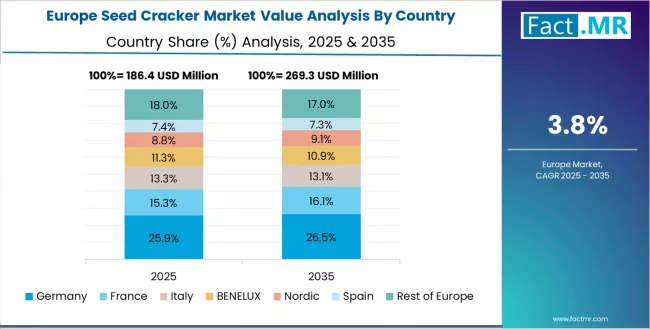
European seed cracker operations are increasingly polarized between Western European precision processing and Eastern European cost-competitive manufacturing. German (USD 160.0 million) and UK facilities (USD 120.0 million) dominate premium healthy snacking and specialty food processing, leveraging advanced food technologies and strict quality protocols that command price premiums in global markets. German processors maintain leadership in high-performance seed cracker applications, with major food companies driving technical specifications that smaller suppliers must meet to access supply contracts.
France (USD 100.0 million), Italy (USD 80.0 million), and Spain (USD 60.0 million) operations focus on specialized applications and regional market requirements. Rest of Europe (USD 220.0 million) including Eastern European operations in Poland, Hungary, and Czech Republic are capturing volume-oriented processing contracts through labor cost advantages and EU regulatory compliance, particularly in standard seed cracker ingredients for retail applications.
The regulatory environment presents both opportunities and constraints. EU food safety regulations and healthy snacking directives create barriers for novel seed cracker formulations but establish quality standards that favor established European processors over imports. Brexit has fragmented UK sourcing from EU suppliers, creating opportunities for direct relationships between processors and British food manufacturers.
Supply chain consolidation accelerates as processors seek economies of scale to absorb rising energy costs and compliance expenses. Vertical integration increases, with major food manufacturers acquiring processing facilities to secure seed cracker supplies and quality control. Smaller processors face pressure to specialize in niche applications or risk displacement by larger, more efficient operations serving mainstream retail manufacturing requirements.
Premium Quality Standards Define Japanese Market Dynamics
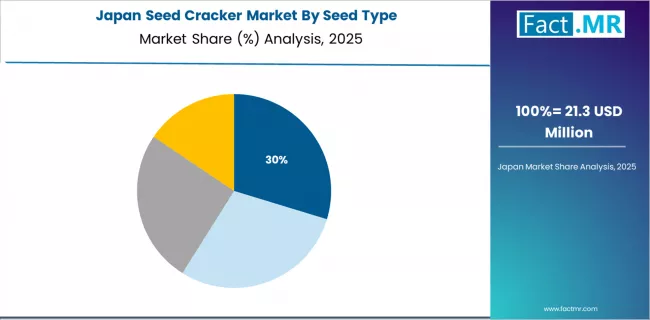
Japanese seed cracker operations reflect the country's exacting quality standards and sophisticated food expectations. Major food manufacturers maintain rigorous supplier qualification processes that often exceed international standards, requiring extensive documentation, batch testing, and facility audits that can take 12-18 months to complete. This creates high barriers for new suppliers but ensures consistent quality that supports premium product positioning.
The Japanese market demonstrates unique application preferences with Retail accounting for 55.0%, Online 30.0%, and Foodservice 15.0%. Companies require specific nutritional profiles and quality specifications that differ from Western applications, driving demand for customized processing capabilities.
Japanese market demonstrates unique seed type preferences with Flax accounting for 35.0%, Chia 30.0%, and Others 35.0%. Companies require specific nutritional content and quality specifications that differ from Western applications, driving demand for customized processing capabilities.
Regulatory oversight emphasizes comprehensive food ingredient management and traceability requirements that surpass most international standards. The food registration system requires detailed ingredient sourcing information, creating advantages for suppliers with transparent supply chains and comprehensive documentation systems.
Supply chain management focuses on relationship-based partnerships rather than purely transactional procurement. Japanese companies typically maintain long-term supplier relationships spanning decades, with annual contract negotiations emphasizing quality consistency over price competition. This stability supports investment in specialized processing equipment tailored to Japanese specifications.
Market Dynamics Drive Innovation in South Korea
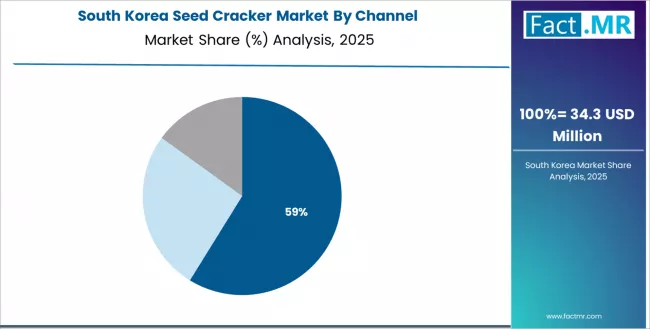
South Korean seed cracker operations reflect the country's advanced food manufacturing sector and export-oriented business model. Major food companies drive sophisticated ingredient procurement strategies, establishing direct relationships with global suppliers to secure consistent quality and pricing for their healthy snacking operations targeting both domestic and international markets.
The Korean market demonstrates strength in channel distribution with Retail accounting for 65.0%, Online 25.0%, and Foodservice 10.0%. This health-focused approach creates demand for specific nutritional specifications that differ from Western applications, requiring suppliers to adapt processing and formulation techniques.
Regulatory frameworks emphasize food ingredient safety and traceability, with Korean food administration standards often exceeding international requirements. This creates barriers for smaller food suppliers but benefits established processors who can demonstrate compliance capabilities. The regulatory environment particularly favors suppliers with comprehensive certification and documentation systems.
Supply chain efficiency remains critical given Korea's geographic limitations and import dependence. Companies increasingly pursue long-term contracts with suppliers in United States, Germany, and Japan to ensure reliable access to raw materials while managing foreign exchange risks. Technical logistics investments support quality preservation during extended shipping periods.
The market faces pressure from rising labor costs and competition from lower-cost regional manufacturers, driving automation investments and consolidation among smaller processors. However, the premium positioning of Korean food brands internationally continues to support demand for high-quality seed cracker ingredients that meet stringent specifications.
Competitive Landscape of Seed Cracker Market

Profit pools are consolidating upstream in scaled seed processing systems and downstream in value-added specialty formulations for retail, online, and foodservice applications where certification, traceability, and consistent nutritional profiles command premiums. Value is migrating from raw ingredient commodity trading to specification-tight, application-ready seed crackers where technical expertise and quality control drive competitive advantage.
Several archetypes set the pace: global food integrators defending share through production scale and technical reliability; multi-format processors that manage complexity and serve diverse channels; specialty seed cracker developers with formulation expertise and retail industry ties; and nutrition-driven suppliers pulling volume in premium health food and specialty retail applications. Switching costs—re-qualification, nutritional testing, performance validation, provide stability for incumbents, while supply shocks and regulatory changes reopen opportunities for diversified suppliers.
Consolidation and verticalization continue; digital procurement emerges in commodity grades while premium specifications remain relationship-led. Focus areas: lock retail and foodservice pipelines with channel-specific formulations and service level agreements; establish multi-format production capabilities and technical disclosure; develop specialized seed cracker formulations with nutritional claims.
| Stakeholder Type | Primary Advantage | Repeatable Plays |
|---|---|---|
| Global food integrators | Scale, production integration, technical reliability | Long-term contracts, tight specs, co-development with retail/foodservice |
| Multi-format processors | Format diversification, channel expertise, supply flexibility | Multi-channel serving, technical support, quality assurance across segments |
| Specialty seed cracker developers | Formulation expertise and industry relationships | Custom formulations, nutritional science, performance SLAs |
| Nutrition-focused suppliers | Health-focused demand and specialized service | Technical nutritional claims, specialized grades, application activation |
| Food distributors & platforms | Technical support for mid-tier manufacturers | Format selection, smaller volumes, technical service |
Key Players in the Seed Cracker Market
- Mary's Gone Crackers, Inc.
- Lenny & Larry's
- Simple Mills, Inc.
- Hippie Snacks (IKE Enterprises Inc., dba Left Coast Naturals)
- Hu Kitchen
- Back to Nature (BA Brussels, LLC, a subsidiary of Barilla America, Inc.)
- Go Raw (Freeland Foods)
- BHU Foods
- Flackers
- Nature's Path Foods
- Enjoy Life Foods
- Germinal
- KIND LLC
- Schär (Dr. Schär AG)
- Finn Crisp (Finn Crisp Oy)
Scope of the Report
| Items | Values |
|---|---|
| Quantitative Units (2025) | USD 740.0 Million |
| Seed Type | Flax, Chia, Sunflower, Others |
| Channel | Retail, Online, Foodservice |
| Nature | Conventional, Organic |
| Regions Covered | North America, Europe, Asia Pacific, Latin America, Middle East & Africa |
| Countries Covered | United States, Germany, China, Japan, India, South Korea, UK, and other 40+ countries |
| Key Companies Profiled | Mary's Gone Crackers, Lenny & Larry's, Simple Mills, Hippie Snacks, Hu Kitchen, Back to Nature, GoRaw, BHU Foods, Flackers, Nature's Path, Enjoy Life, Germinal, KIND, Schar, Finn Crisp |
| Additional Attributes | Dollar sales by seed type/channel/nature, regional demand (NA, EU, APAC), competitive landscape, conventional vs. organic adoption, production/processing integration, and advanced processing innovations driving nutritional enhancement, technical advancement, and efficiency |
Seed Cracker Market Segmentation
-
By Seed Type :
- Flax
- Chia
- Sunflower
- Others
-
By Channel :
- Retail
- Online
- Foodservice
-
By Nature :
- Conventional
- Organic
-
By Region :
- North America
- Europe
- Asia Pacific
- Latin America
- Middle East & Africa
Table of Content
- Executive Summary
- Global Market Outlook
- Demand to side Trends
- Supply to side Trends
- Technology Roadmap Analysis
- Analysis and Recommendations
- Market Overview
- Market Coverage / Taxonomy
- Market Definition / Scope / Limitations
- Market Background
- Market Dynamics
- Drivers
- Restraints
- Opportunity
- Trends
- Scenario Forecast
- Demand in Optimistic Scenario
- Demand in Likely Scenario
- Demand in Conservative Scenario
- Opportunity Map Analysis
- Product Life Cycle Analysis
- Supply Chain Analysis
- Investment Feasibility Matrix
- Value Chain Analysis
- PESTLE and Porter’s Analysis
- Regulatory Landscape
- Regional Parent Market Outlook
- Production and Consumption Statistics
- Import and Export Statistics
- Market Dynamics
- Global Market Analysis 2020 to 2024 and Forecast, 2025 to 2035
- Historical Market Size Value (USD Million) Analysis, 2020 to 2024
- Current and Future Market Size Value (USD Million) Projections, 2025 to 2035
- Y to o to Y Growth Trend Analysis
- Absolute $ Opportunity Analysis
- Global Market Pricing Analysis 2020 to 2024 and Forecast 2025 to 2035
- Global Market Analysis 2020 to 2024 and Forecast 2025 to 2035, By Seed Type
- Introduction / Key Findings
- Historical Market Size Value (USD Million) Analysis By Seed Type , 2020 to 2024
- Current and Future Market Size Value (USD Million) Analysis and Forecast By Seed Type , 2025 to 2035
- Flax
- Chia
- Sunflower
- Others
- Y to o to Y Growth Trend Analysis By Seed Type , 2020 to 2024
- Absolute $ Opportunity Analysis By Seed Type , 2025 to 2035
- Global Market Analysis 2020 to 2024 and Forecast 2025 to 2035, By Channel
- Introduction / Key Findings
- Historical Market Size Value (USD Million) Analysis By Channel, 2020 to 2024
- Current and Future Market Size Value (USD Million) Analysis and Forecast By Channel, 2025 to 2035
- Retail
- Online
- Foodservice
- Y to o to Y Growth Trend Analysis By Channel, 2020 to 2024
- Absolute $ Opportunity Analysis By Channel, 2025 to 2035
- Global Market Analysis 2020 to 2024 and Forecast 2025 to 2035, By Nature
- Introduction / Key Findings
- Historical Market Size Value (USD Million) Analysis By Nature, 2020 to 2024
- Current and Future Market Size Value (USD Million) Analysis and Forecast By Nature, 2025 to 2035
- Conventional
- Organic
- Y to o to Y Growth Trend Analysis By Nature, 2020 to 2024
- Absolute $ Opportunity Analysis By Nature, 2025 to 2035
- Global Market Analysis 2020 to 2024 and Forecast 2025 to 2035, By Region
- Introduction
- Historical Market Size Value (USD Million) Analysis By Region, 2020 to 2024
- Current Market Size Value (USD Million) Analysis and Forecast By Region, 2025 to 2035
- North America
- Latin America
- Western Europe
- Eastern Europe
- East Asia
- South Asia and Pacific
- Middle East & Africa
- Market Attractiveness Analysis By Region
- North America Market Analysis 2020 to 2024 and Forecast 2025 to 2035, By Country
- Historical Market Size Value (USD Million) Trend Analysis By Market Taxonomy, 2020 to 2024
- Market Size Value (USD Million) Forecast By Market Taxonomy, 2025 to 2035
- By Country
- USA
- Canada
- Mexico
- By Seed Type
- By Channel
- By Nature
- By Country
- Market Attractiveness Analysis
- By Country
- By Seed Type
- By Channel
- By Nature
- Key Takeaways
- Latin America Market Analysis 2020 to 2024 and Forecast 2025 to 2035, By Country
- Historical Market Size Value (USD Million) Trend Analysis By Market Taxonomy, 2020 to 2024
- Market Size Value (USD Million) Forecast By Market Taxonomy, 2025 to 2035
- By Country
- Brazil
- Chile
- Rest of Latin America
- By Seed Type
- By Channel
- By Nature
- By Country
- Market Attractiveness Analysis
- By Country
- By Seed Type
- By Channel
- By Nature
- Key Takeaways
- Western Europe Market Analysis 2020 to 2024 and Forecast 2025 to 2035, By Country
- Historical Market Size Value (USD Million) Trend Analysis By Market Taxonomy, 2020 to 2024
- Market Size Value (USD Million) Forecast By Market Taxonomy, 2025 to 2035
- By Country
- Germany
- UK
- Italy
- Spain
- France
- Nordic
- BENELUX
- Rest of Western Europe
- By Seed Type
- By Channel
- By Nature
- By Country
- Market Attractiveness Analysis
- By Country
- By Seed Type
- By Channel
- By Nature
- Key Takeaways
- Eastern Europe Market Analysis 2020 to 2024 and Forecast 2025 to 2035, By Country
- Historical Market Size Value (USD Million) Trend Analysis By Market Taxonomy, 2020 to 2024
- Market Size Value (USD Million) Forecast By Market Taxonomy, 2025 to 2035
- By Country
- Russia
- Poland
- Hungary
- Balkan & Baltic
- Rest of Eastern Europe
- By Seed Type
- By Channel
- By Nature
- By Country
- Market Attractiveness Analysis
- By Country
- By Seed Type
- By Channel
- By Nature
- Key Takeaways
- East Asia Market Analysis 2020 to 2024 and Forecast 2025 to 2035, By Country
- Historical Market Size Value (USD Million) Trend Analysis By Market Taxonomy, 2020 to 2024
- Market Size Value (USD Million) Forecast By Market Taxonomy, 2025 to 2035
- By Country
- China
- Japan
- South Korea
- By Seed Type
- By Channel
- By Nature
- By Country
- Market Attractiveness Analysis
- By Country
- By Seed Type
- By Channel
- By Nature
- Key Takeaways
- South Asia and Pacific Market Analysis 2020 to 2024 and Forecast 2025 to 2035, By Country
- Historical Market Size Value (USD Million) Trend Analysis By Market Taxonomy, 2020 to 2024
- Market Size Value (USD Million) Forecast By Market Taxonomy, 2025 to 2035
- By Country
- India
- ASEAN
- Australia & New Zealand
- Rest of South Asia and Pacific
- By Seed Type
- By Channel
- By Nature
- By Country
- Market Attractiveness Analysis
- By Country
- By Seed Type
- By Channel
- By Nature
- Key Takeaways
- Middle East & Africa Market Analysis 2020 to 2024 and Forecast 2025 to 2035, By Country
- Historical Market Size Value (USD Million) Trend Analysis By Market Taxonomy, 2020 to 2024
- Market Size Value (USD Million) Forecast By Market Taxonomy, 2025 to 2035
- By Country
- Kingdom of Saudi Arabia
- Other GCC Countries
- Turkiye
- South Africa
- Other African Union
- Rest of Middle East & Africa
- By Seed Type
- By Channel
- By Nature
- By Country
- Market Attractiveness Analysis
- By Country
- By Seed Type
- By Channel
- By Nature
- Key Takeaways
- Key Countries Market Analysis
- USA
- Pricing Analysis
- Market Share Analysis, 2024
- By Seed Type
- By Channel
- By Nature
- Canada
- Pricing Analysis
- Market Share Analysis, 2024
- By Seed Type
- By Channel
- By Nature
- Mexico
- Pricing Analysis
- Market Share Analysis, 2024
- By Seed Type
- By Channel
- By Nature
- Brazil
- Pricing Analysis
- Market Share Analysis, 2024
- By Seed Type
- By Channel
- By Nature
- Chile
- Pricing Analysis
- Market Share Analysis, 2024
- By Seed Type
- By Channel
- By Nature
- Germany
- Pricing Analysis
- Market Share Analysis, 2024
- By Seed Type
- By Channel
- By Nature
- UK
- Pricing Analysis
- Market Share Analysis, 2024
- By Seed Type
- By Channel
- By Nature
- Italy
- Pricing Analysis
- Market Share Analysis, 2024
- By Seed Type
- By Channel
- By Nature
- Spain
- Pricing Analysis
- Market Share Analysis, 2024
- By Seed Type
- By Channel
- By Nature
- France
- Pricing Analysis
- Market Share Analysis, 2024
- By Seed Type
- By Channel
- By Nature
- India
- Pricing Analysis
- Market Share Analysis, 2024
- By Seed Type
- By Channel
- By Nature
- ASEAN
- Pricing Analysis
- Market Share Analysis, 2024
- By Seed Type
- By Channel
- By Nature
- Australia & New Zealand
- Pricing Analysis
- Market Share Analysis, 2024
- By Seed Type
- By Channel
- By Nature
- China
- Pricing Analysis
- Market Share Analysis, 2024
- By Seed Type
- By Channel
- By Nature
- Japan
- Pricing Analysis
- Market Share Analysis, 2024
- By Seed Type
- By Channel
- By Nature
- South Korea
- Pricing Analysis
- Market Share Analysis, 2024
- By Seed Type
- By Channel
- By Nature
- Russia
- Pricing Analysis
- Market Share Analysis, 2024
- By Seed Type
- By Channel
- By Nature
- Poland
- Pricing Analysis
- Market Share Analysis, 2024
- By Seed Type
- By Channel
- By Nature
- Hungary
- Pricing Analysis
- Market Share Analysis, 2024
- By Seed Type
- By Channel
- By Nature
- Kingdom of Saudi Arabia
- Pricing Analysis
- Market Share Analysis, 2024
- By Seed Type
- By Channel
- By Nature
- Turkiye
- Pricing Analysis
- Market Share Analysis, 2024
- By Seed Type
- By Channel
- By Nature
- South Africa
- Pricing Analysis
- Market Share Analysis, 2024
- By Seed Type
- By Channel
- By Nature
- USA
- Market Structure Analysis
- Competition Dashboard
- Competition Benchmarking
- Market Share Analysis of Top Players
- By Regional
- By Seed Type
- By Channel
- By Nature
- Competition Analysis
- Competition Deep Dive
- Mary's Gone Crackers, Inc.
- Overview
- Product Portfolio
- Profitability by Market Segments (Product/Age /Sales Channel/Region)
- Sales Footprint
- Strategy Overview
- Marketing Strategy
- Product Strategy
- Channel Strategy
- Lenny & Larry's
- Simple Mills, Inc.
- Hippie Snacks (IKE Enterprises Inc., dba Left Coast Naturals)
- Hu Kitchen
- Back to Nature (BA Brussels, LLC, a subsidiary of Barilla America, Inc.)
- Go Raw (Freeland Foods)
- BHU Foods
- Flackers
- Nature's Path Foods
- Enjoy Life Foods
- Germinal
- KIND LLC
- Schär (Dr. Schär AG)
- Finn Crisp (Finn Crisp Oy)
- Mary's Gone Crackers, Inc.
- Competition Deep Dive
- Assumptions & Acronyms Used
- Research Methodology
List Of Table
- Table 1: Global Market Value (USD Million) Forecast by Region, 2020 to 2035
- Table 2: Global Market Value (USD Million) Forecast by Seed Type , 2020 to 2035
- Table 3: Global Market Value (USD Million) Forecast by Channel, 2020 to 2035
- Table 4: Global Market Value (USD Million) Forecast by Nature, 2020 to 2035
- Table 5: North America Market Value (USD Million) Forecast by Country, 2020 to 2035
- Table 6: North America Market Value (USD Million) Forecast by Seed Type , 2020 to 2035
- Table 7: North America Market Value (USD Million) Forecast by Channel, 2020 to 2035
- Table 8: North America Market Value (USD Million) Forecast by Nature, 2020 to 2035
- Table 9: Latin America Market Value (USD Million) Forecast by Country, 2020 to 2035
- Table 10: Latin America Market Value (USD Million) Forecast by Seed Type , 2020 to 2035
- Table 11: Latin America Market Value (USD Million) Forecast by Channel, 2020 to 2035
- Table 12: Latin America Market Value (USD Million) Forecast by Nature, 2020 to 2035
- Table 13: Western Europe Market Value (USD Million) Forecast by Country, 2020 to 2035
- Table 14: Western Europe Market Value (USD Million) Forecast by Seed Type , 2020 to 2035
- Table 15: Western Europe Market Value (USD Million) Forecast by Channel, 2020 to 2035
- Table 16: Western Europe Market Value (USD Million) Forecast by Nature, 2020 to 2035
- Table 17: Eastern Europe Market Value (USD Million) Forecast by Country, 2020 to 2035
- Table 18: Eastern Europe Market Value (USD Million) Forecast by Seed Type , 2020 to 2035
- Table 19: Eastern Europe Market Value (USD Million) Forecast by Channel, 2020 to 2035
- Table 20: Eastern Europe Market Value (USD Million) Forecast by Nature, 2020 to 2035
- Table 21: East Asia Market Value (USD Million) Forecast by Country, 2020 to 2035
- Table 22: East Asia Market Value (USD Million) Forecast by Seed Type , 2020 to 2035
- Table 23: East Asia Market Value (USD Million) Forecast by Channel, 2020 to 2035
- Table 24: East Asia Market Value (USD Million) Forecast by Nature, 2020 to 2035
- Table 25: South Asia and Pacific Market Value (USD Million) Forecast by Country, 2020 to 2035
- Table 26: South Asia and Pacific Market Value (USD Million) Forecast by Seed Type , 2020 to 2035
- Table 27: South Asia and Pacific Market Value (USD Million) Forecast by Channel, 2020 to 2035
- Table 28: South Asia and Pacific Market Value (USD Million) Forecast by Nature, 2020 to 2035
- Table 29: Middle East & Africa Market Value (USD Million) Forecast by Country, 2020 to 2035
- Table 30: Middle East & Africa Market Value (USD Million) Forecast by Seed Type , 2020 to 2035
- Table 31: Middle East & Africa Market Value (USD Million) Forecast by Channel, 2020 to 2035
- Table 32: Middle East & Africa Market Value (USD Million) Forecast by Nature, 2020 to 2035
List Of Figures
- Figure 1: Global Market Pricing Analysis
- Figure 2: Global Market Value (USD Million) Forecast 2020-2035
- Figure 3: Global Market Value Share and BPS Analysis by Seed Type , 2025 and 2035
- Figure 4: Global Market Y to o to Y Growth Comparison by Seed Type , 2025-2035
- Figure 5: Global Market Attractiveness Analysis by Seed Type
- Figure 6: Global Market Value Share and BPS Analysis by Channel, 2025 and 2035
- Figure 7: Global Market Y to o to Y Growth Comparison by Channel, 2025-2035
- Figure 8: Global Market Attractiveness Analysis by Channel
- Figure 9: Global Market Value Share and BPS Analysis by Nature, 2025 and 2035
- Figure 10: Global Market Y to o to Y Growth Comparison by Nature, 2025-2035
- Figure 11: Global Market Attractiveness Analysis by Nature
- Figure 12: Global Market Value (USD Million) Share and BPS Analysis by Region, 2025 and 2035
- Figure 13: Global Market Y to o to Y Growth Comparison by Region, 2025-2035
- Figure 14: Global Market Attractiveness Analysis by Region
- Figure 15: North America Market Incremental Dollar Opportunity, 2025-2035
- Figure 16: Latin America Market Incremental Dollar Opportunity, 2025-2035
- Figure 17: Western Europe Market Incremental Dollar Opportunity, 2025-2035
- Figure 18: Eastern Europe Market Incremental Dollar Opportunity, 2025-2035
- Figure 19: East Asia Market Incremental Dollar Opportunity, 2025-2035
- Figure 20: South Asia and Pacific Market Incremental Dollar Opportunity, 2025-2035
- Figure 21: Middle East & Africa Market Incremental Dollar Opportunity, 2025-2035
- Figure 22: North America Market Value Share and BPS Analysis by Country, 2025 and 2035
- Figure 23: North America Market Value Share and BPS Analysis by Seed Type , 2025 and 2035
- Figure 24: North America Market Y to o to Y Growth Comparison by Seed Type , 2025-2035
- Figure 25: North America Market Attractiveness Analysis by Seed Type
- Figure 26: North America Market Value Share and BPS Analysis by Channel, 2025 and 2035
- Figure 27: North America Market Y to o to Y Growth Comparison by Channel, 2025-2035
- Figure 28: North America Market Attractiveness Analysis by Channel
- Figure 29: North America Market Value Share and BPS Analysis by Nature, 2025 and 2035
- Figure 30: North America Market Y to o to Y Growth Comparison by Nature, 2025-2035
- Figure 31: North America Market Attractiveness Analysis by Nature
- Figure 32: Latin America Market Value Share and BPS Analysis by Country, 2025 and 2035
- Figure 33: Latin America Market Value Share and BPS Analysis by Seed Type , 2025 and 2035
- Figure 34: Latin America Market Y to o to Y Growth Comparison by Seed Type , 2025-2035
- Figure 35: Latin America Market Attractiveness Analysis by Seed Type
- Figure 36: Latin America Market Value Share and BPS Analysis by Channel, 2025 and 2035
- Figure 37: Latin America Market Y to o to Y Growth Comparison by Channel, 2025-2035
- Figure 38: Latin America Market Attractiveness Analysis by Channel
- Figure 39: Latin America Market Value Share and BPS Analysis by Nature, 2025 and 2035
- Figure 40: Latin America Market Y to o to Y Growth Comparison by Nature, 2025-2035
- Figure 41: Latin America Market Attractiveness Analysis by Nature
- Figure 42: Western Europe Market Value Share and BPS Analysis by Country, 2025 and 2035
- Figure 43: Western Europe Market Value Share and BPS Analysis by Seed Type , 2025 and 2035
- Figure 44: Western Europe Market Y to o to Y Growth Comparison by Seed Type , 2025-2035
- Figure 45: Western Europe Market Attractiveness Analysis by Seed Type
- Figure 46: Western Europe Market Value Share and BPS Analysis by Channel, 2025 and 2035
- Figure 47: Western Europe Market Y to o to Y Growth Comparison by Channel, 2025-2035
- Figure 48: Western Europe Market Attractiveness Analysis by Channel
- Figure 49: Western Europe Market Value Share and BPS Analysis by Nature, 2025 and 2035
- Figure 50: Western Europe Market Y to o to Y Growth Comparison by Nature, 2025-2035
- Figure 51: Western Europe Market Attractiveness Analysis by Nature
- Figure 52: Eastern Europe Market Value Share and BPS Analysis by Country, 2025 and 2035
- Figure 53: Eastern Europe Market Value Share and BPS Analysis by Seed Type , 2025 and 2035
- Figure 54: Eastern Europe Market Y to o to Y Growth Comparison by Seed Type , 2025-2035
- Figure 55: Eastern Europe Market Attractiveness Analysis by Seed Type
- Figure 56: Eastern Europe Market Value Share and BPS Analysis by Channel, 2025 and 2035
- Figure 57: Eastern Europe Market Y to o to Y Growth Comparison by Channel, 2025-2035
- Figure 58: Eastern Europe Market Attractiveness Analysis by Channel
- Figure 59: Eastern Europe Market Value Share and BPS Analysis by Nature, 2025 and 2035
- Figure 60: Eastern Europe Market Y to o to Y Growth Comparison by Nature, 2025-2035
- Figure 61: Eastern Europe Market Attractiveness Analysis by Nature
- Figure 62: East Asia Market Value Share and BPS Analysis by Country, 2025 and 2035
- Figure 63: East Asia Market Value Share and BPS Analysis by Seed Type , 2025 and 2035
- Figure 64: East Asia Market Y to o to Y Growth Comparison by Seed Type , 2025-2035
- Figure 65: East Asia Market Attractiveness Analysis by Seed Type
- Figure 66: East Asia Market Value Share and BPS Analysis by Channel, 2025 and 2035
- Figure 67: East Asia Market Y to o to Y Growth Comparison by Channel, 2025-2035
- Figure 68: East Asia Market Attractiveness Analysis by Channel
- Figure 69: East Asia Market Value Share and BPS Analysis by Nature, 2025 and 2035
- Figure 70: East Asia Market Y to o to Y Growth Comparison by Nature, 2025-2035
- Figure 71: East Asia Market Attractiveness Analysis by Nature
- Figure 72: South Asia and Pacific Market Value Share and BPS Analysis by Country, 2025 and 2035
- Figure 73: South Asia and Pacific Market Value Share and BPS Analysis by Seed Type , 2025 and 2035
- Figure 74: South Asia and Pacific Market Y to o to Y Growth Comparison by Seed Type , 2025-2035
- Figure 75: South Asia and Pacific Market Attractiveness Analysis by Seed Type
- Figure 76: South Asia and Pacific Market Value Share and BPS Analysis by Channel, 2025 and 2035
- Figure 77: South Asia and Pacific Market Y to o to Y Growth Comparison by Channel, 2025-2035
- Figure 78: South Asia and Pacific Market Attractiveness Analysis by Channel
- Figure 79: South Asia and Pacific Market Value Share and BPS Analysis by Nature, 2025 and 2035
- Figure 80: South Asia and Pacific Market Y to o to Y Growth Comparison by Nature, 2025-2035
- Figure 81: South Asia and Pacific Market Attractiveness Analysis by Nature
- Figure 82: Middle East & Africa Market Value Share and BPS Analysis by Country, 2025 and 2035
- Figure 83: Middle East & Africa Market Value Share and BPS Analysis by Seed Type , 2025 and 2035
- Figure 84: Middle East & Africa Market Y to o to Y Growth Comparison by Seed Type , 2025-2035
- Figure 85: Middle East & Africa Market Attractiveness Analysis by Seed Type
- Figure 86: Middle East & Africa Market Value Share and BPS Analysis by Channel, 2025 and 2035
- Figure 87: Middle East & Africa Market Y to o to Y Growth Comparison by Channel, 2025-2035
- Figure 88: Middle East & Africa Market Attractiveness Analysis by Channel
- Figure 89: Middle East & Africa Market Value Share and BPS Analysis by Nature, 2025 and 2035
- Figure 90: Middle East & Africa Market Y to o to Y Growth Comparison by Nature, 2025-2035
- Figure 91: Middle East & Africa Market Attractiveness Analysis by Nature
- Figure 92: Global Market - Tier Structure Analysis
- Figure 93: Global Market - Company Share Analysis
- FAQs -
How big is the seed cracker market in 2025?
The global seed cracker market is estimated to be valued at USD 740.0 million in 2025.
What will be the size of seed cracker market in 2035?
The market size for the seed cracker market is projected to reach USD 1,150.0 million by 2035.
How much will be the seed cracker market growth between 2025 and 2035?
The seed cracker market is expected to grow at a 4.5% CAGR between 2025 and 2035.
What are the key product types in the seed cracker market?
The key product types in seed cracker market are flax, chia, sunflower and others.
Which channel segment to contribute significant share in the seed cracker market in 2025?
In terms of channel, retail segment to command 60.0% share in the seed cracker market in 2025.